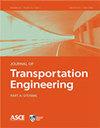Urban Mobility in the Postpandemic Stage: A Comprehensive Investigation of a Variety of Cities in China
IF 1.8
4区 工程技术
Q3 ENGINEERING, CIVIL
Journal of Transportation Engineering Part A-Systems
Pub Date : 2023-08-01
DOI:10.1061/jtepbs.teeng-7287
引用次数: 0
Abstract
The global outbreak of coronavirus disease 2019 (COVID-19) has affected the urban mobility of nations around the world. The pandemic may even have a potentially lasting impact on travel behaviors during the post-pandemic stage. China has basically stopped the spread of COVID-19 and reopened the economy, providing an unprecedented environment for investigating post-pandemic travel behaviors. This study conducts multiple investigations to show the changes in travel behaviors in the post-pandemic stage, on the basis of empirical travel data in a variety of cities in China. Specifically, this study demonstrates the changes in road network travel speed in 57 case cities and the changes in subway ridership in 26 case cities. Comprehensive comparisons can indicate the potential modal share in the post-pandemic stage. Further, this study conducts a case analysis of Beijing, where the city has experienced two waves of COVID-19. The variations in travel speed in the road network of Beijing at different stages of the pandemic help reveal the public's responses towards the varying severity of the pandemic. Finally, a case study of the Yuhang district in Hangzhou is conducted to demonstrate the changes in traffic volume and vehicle travel distance amid the post-pandemic stage based on license plate recognition data. Results indicate a decline in subway trips in the post-pandemic stage among case cities. The vehicular traffic in cities with subways has recovered in peak hours on weekdays and has been even more congested than the pre-pandemic levels;whereas the vehicular traffic in cities without subways has not rebounded to pre-pandemic levels. This situation implies a potential modal shift from public transportation to private vehicular travel modes. Results also indicate that commuting traffic is sensitive to the severity of the pandemic. This may be because countermeasures, e.g., work-from-home and suspension of non-essential businesses, will be implemented if the pandemic restarts. The travel speed in non-peak hours and on non-workdays is higher than pre-pandemic levels, indicating that non-essential travel demand may be reduced and the public's vigilance towards the pandemic may continue to the post-pandemic stage. These findings can help improve policymaking strategies in the post-pandemic new normal. © 2023 American Society of Civil Engineers.大流行后阶段的城市流动性:对中国多个城市的综合调查
2019冠状病毒病(COVID-19)的全球爆发影响了世界各国的城市流动性。大流行甚至可能对大流行后阶段的旅行行为产生潜在的持久影响。中国已经基本遏制了新冠肺炎疫情的传播,并重新开放了经济,为调查疫情后的旅行行为提供了前所未有的环境。本研究以中国多个城市的实证旅行数据为基础,开展多项调查,展示疫情后阶段旅行行为的变化。具体而言,本研究展示了57个案例城市的路网运行速度变化和26个案例城市的地铁客流量变化。综合比较可显示大流行后阶段潜在的模态份额。此外,本研究还以北京为例进行了分析,该城市经历了两波新冠肺炎。在疫情的不同阶段,北京道路网络的行驶速度变化有助于揭示公众对疫情不同严重程度的反应。最后,以杭州市余杭区为例,分析基于车牌识别数据的疫情后阶段交通流量和车辆行驶距离的变化。结果表明,病例城市的地铁出行在大流行后阶段有所下降。有地铁城市的车辆流量在工作日高峰时段有所恢复,拥堵程度甚至超过疫情前水平;而没有地铁城市的车辆流量尚未恢复到疫情前水平。这种情况意味着从公共交通到私人交通的潜在模式转变。结果还表明,通勤交通对大流行的严重程度敏感。这可能是因为,如果疫情重新爆发,将实施在家办公和暂停非必要业务等对策。非高峰时段和非工作日的旅行速度高于大流行前的水平,表明非必要的旅行需求可能会减少,公众对大流行的警惕可能会持续到大流行后阶段。这些发现有助于改善大流行后新常态下的决策策略。©2023美国土木工程师学会。
本文章由计算机程序翻译,如有差异,请以英文原文为准。
求助全文
约1分钟内获得全文
求助全文
来源期刊

Journal of Transportation Engineering Part A-Systems
Social Sciences-Transportation
CiteScore
3.80
自引率
14.30%
发文量
152
期刊介绍:
The Journal of Transportation Engineering will be renamed the Journal of Transportation Engineering, Part A: Systems. This change will take effect with the January 2017 issue. The editorial board remains the same and papers in review will continue through the process without delay. A new journal has been launched, Journal of Transportation Engineering, Part B: Pavements. The first issue will appear in 2017.
 求助内容:
求助内容: 应助结果提醒方式:
应助结果提醒方式:


